
Coins of Jetisu (Semirechye) with images and descriptions
History of Semirechye
Semirechye (“Seven Rivers”) region is located on the territory of modern day Kyrgyzstan and Kazakhstan. The name is derrived from the seven rivers flowing into the lake Balhash.
Formation of elements of statehood of the people of Semirechye relates to the middle of the 1st millennium A.D. Ties were established with Byzantium, India, China, Eastern Europe. From the 7th century Semirechye, along with other lands from China to the Syrdarya river, became Turkic possessions. Turks became actively involved in international silk trade, and also became intermediaries between China and Western states.
During 7th – 8th centuries, valleys of rivers Talas, Chu and Ili were intensively colonized by Sogdians, which to the establishment there of tens of cities and fortified settlements. In the 7th century, the strongest tribe, the Tugreshs seized power. During the second half of the 8th century, the supremacy transferred over to the Karluk people.
At the end of the 8th century, the Arabs were in the process of pushing the Karluks out of Ferghana. But in the north-west, in Semirechye the Arabs were stopped at the battle at Talas (in 751 A.D.) and did not advance any further to the east. Mass migration of Sogdians during this period promoted further grouth of cities and settlements in the Semirechye region.
During this time, monetary circulation begins and develops in the cities of Semirechye. The date of production of the first coins on the territory of Semirechye cannot be determined precisely. Cast bronze coins were issued on the territory from Middle Syrdarya to the Irtysh River. The major locations of finds of Tugresh coins, and therefore the centers of their production were settlements of Suyab, Navekat and Taraz.
The state, which formed in the middle of the 10th century on the territory of Semirechye and Eastern Turkestan, and having acquired the name of “Qarakhanids” by science, adopted Islam as the state religion. The Qarakhanids adopted the organization of monetary economy and the technology of coin production, which by that time was affirmed by the entire Islamic East. The coins of the Chinese type started to get pushed out of circulation in favor of copper fals and silver dirhams. With that, early medieval monetary complex of Semirechye, having consisted of cast bronze coins, seized to exist.
Coins catalog of Semirechye
City Suyab
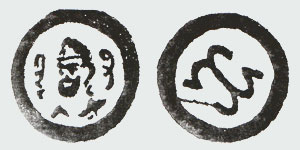
Sr2 City Suyab.
Unknown ruler. Obverse: Bust-length image of the ruler (ruler) three-quarters to the left, wearing a bashlyk-shaped headdress.
There are large earrings in the ears.
To the right and left of the portrait is a Sogdian legend. Reverse: In the center of the coin is the tamga sign of the Turgesh, in the form of a stylized letter of the runic alphabet. ( # 54 A.M. Kamyshev, Early medieval coin complex of Semirechye. # 20). Bronze.
/Extremely Rare/
Turgesh Khaganate
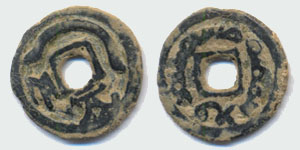
Sr3 Turgesh Khaganate.
Sovereign Vakhshutava.
VIII century. Obverse: Around the square hole is the Sogdian legend “money of sovereign Vakhshutav”. Reverse: Tamga of the Turgeshes.
On the bottom left is a tamga sign in the form of the runic letter, on the right is the hieroglyph yuan. (#54 A.M.Kamyshev, Early medieval coin complex of Semirechye. #21). Bronze.
D-23 mm.
Weight 3.8 grams.
/Very Rare/

Sr4 Turgesh Khaganate.
First half of the 8th century. Obverse: Around the square hole is the Sogdian legend “lord of the Turgesh Kagan fan.” Reverse: Tamga of the Turgeshes.
On the left is a sign in the form of the runic letter, below is a Sogdian legend consisting of one word. ( # 54 A.M. Kamyshev, Early medieval coinage…, # 22). Bronze.
/Extremely Rare/

Sr5 Turgesh Khaganate.
Second half of the 8th century. Obverse: Around the square hole is the Sogdian legend “lord of the Turgesh Kagan fan.” Reverse: Tamga of the Turgeshes.
On the left is a sign in the form of the runic letter, below is a Sogdian legend consisting of one word. ( # 54 A.M. Kamyshev, Early medieval coinage…, # 23). Bronze.
/Extremely Rare/

Sr6 Turgesh Khaganate.
First half of the 8th century – until the middle of the 9th century. Obverse: Around the square hole is the Sogdian legend “lord of the Turgesh Kagan fan.” Reverse of the Turgesh Tamga in the form of a stylized letter of the runic alphabet. ( # 54 A.M. Kamyshev, Early medieval coinage…, # 24). Bronze.
D-25 mm.
Weight: 5.7 grams.
/Scarce/
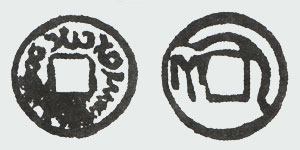
Sr7 Turgesh Khaganate.
First half of the 8th century. Obverse: Around the square hole is the Sogdian legend “lord of the Turgesh Kagan fan.” Reverse: Tamga of the Turgeshes.
On the left is a sign in the form of the runic letter. ( # 54 A.M. Kamyshev, Early medieval coinage…, # 28). Bronze.
/Extremely Rare/
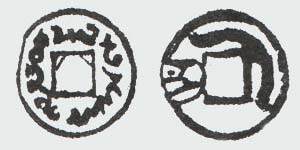
Sr8 Turgesh Khaganate.
First half of the 8th century – until the middle of the 9th century. Obverse: Around the square hole is the Sogdian legend “lord of the Turgesh Kagan fan.”
Reverse: In addition to the tamga of the Turgesh, a tamga sign in the form of a stylized runic letter with a dot in the middle was added to the field of the coin.
This type of coin has differences in the location of the tamga sign relative to the square hole. (#54 A.M.Kamyshev, Early medieval coinage…, #30). Bronze.
/Very Rare/
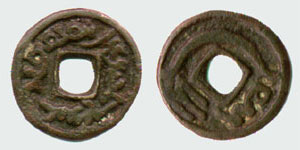
Sr9 Turgesh Khaganate.
Sovereign Inal-Tegin.
Mid-8th century. Obverse: Around the square hole is the Sogdian legend “fan of the sovereign Inal-Tegin”. Reverse: Tamga of the Turgeshes.
On the left is a sign in the form of the runic letter, below is a Sogdian legend consisting of one word. ( # 54 A.M. Kamyshev, Early medieval coinage…, # 33). Bronze.
D-23 mm.
Weight 4.1 grams.
/Extremely Rare/

Sr10 Turgesh Khaganate.
Sovereign Inal-Tegin.
Mid-8th century. Obverse: Around the square hole is a distorted Sogdian legend “of the sovereign Inal-Tegin fan.” Reverse: Tamga of the Turgeshes.
On the left is a sign in the form of the runic letter, below is a distorted Sogdian legend consisting of one word. ( # 54 A.M. Kamyshev, Early medieval coinage…, # 34). Bronze.
/Extremely Rare/
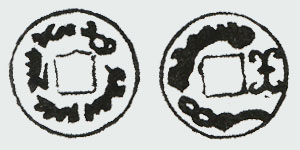
Sr11 Turgesh Khaganate.
Sovereign Hai-Inal-Anir.
First half of the 8th century. Obverse: Around the square hole is the Sogdian legend “of the sovereign Hay-Inal-Anir fan”. Reverse: Around the square hole is a distorted Sogdian legend.
To the right of the hole is a tamga sign. (#54 A.M.Kamyshev, Early medieval coinage…, #35). Bronze.
/Extremely Rare/
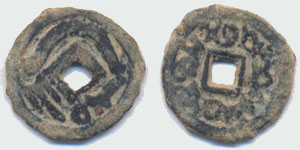
Sr12 Turgesh Khaganate.
Sovereign Vakhshutava.
VIII century. Obverse: Around the square hole is the Sogdian legend “money of sovereign Vakhshutav.” Reverse: Tamga of the Turgeshes.
On the left is a sign in the form of the runic letter, below is a Sogdian legend consisting of one word. (#54 A.M.Kamyshev, Early medieval coinage…, #36). Bronze.
/Extremely Rare/
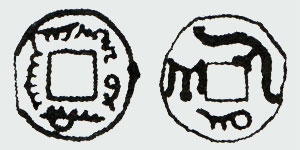
Sr13 Turgesh Khaganate.
Second half of the 8th – beginning of the 9th century. Around the square hole is a Sogdian legend, read clockwise. Reverse: Tamga of the Turgeshes.
On the left is a sign in the form of the runic letter, below is a Sogdian legend consisting of one word. ( # 54 A.M. Kamyshev, Early medieval coinage…, # 37). Bronze.
/Very Rare/
Tukhuses
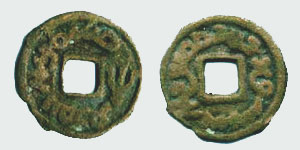
Sr14 Tukhuses.
Second half of the 8th century. Obverse: Around the square hole is the Sogdian legend “Tukhu sovereign”. To the right of the hole is a tamga sign in the form of a trident. Reverse: Around the square hole is the Sogdian legend “the lord of the Turgesh Kagan fan.” (#54 A.M.Kamyshev, Early medieval coinage…, #39). Bronze.
D-20 mm.
Weight – 1.4 grams.
/Scarce/
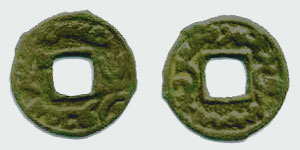
Sr15 Tukhuses.
Second half of the 8th century. Obverse: Around the square hole is the Sogdian legend “Tukhu sovereign”. To the right of the hole is a tamga sign in the form of a trident, resting on an arc with a dot in the center. Reverse: Around the square hole is the Sogdian legend “the lord of the Turgesh Kagan fan.” ( # 54 A.M. Kamyshev, Early medieval coinage…, # 42). Bronze.
/Scarce/
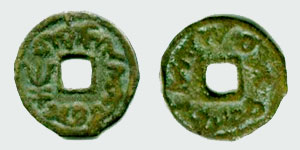
Sr16 Tukhuses.
Second half of the 8th century. Obverse: Around the square hole is a Sogdian legend, read clockwise.
To the left of the hole is a tamga sign. Reverse: Around the square hole is the Sogdian legend, read clockwise “Turgesh kagan fan”. ( # 54 A.M. Kamyshev, Early medieval coinage…, # 43). Bronze.
/Extremely Rare/
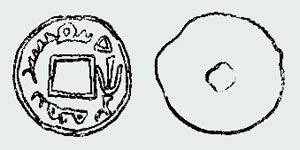
Sr17 Tukhuses.
9th century Obverse: Around the square hole is the Sogdian legend.
To the right of the hole is a tamga sign in the form of a trident. Reverse: Smooth, no differences. ( # 54 A.M. Kamyshev, Early medieval coinage…, # 44). Bronze.
/Very Rare/
Arslanids
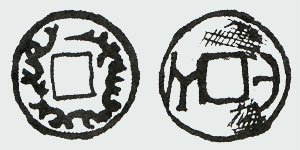
Sr18 Arslanids.
Beginning of the 8th century. Obverse: Around the square hole is the Sogdian legend “Arslan kul-irkin”. Reverse: To the right and left of the hole is a tamga sign. ( # 54 A.M. Kamyshev, Early medieval coinage…, # 45). Bronze.
/Extremely Rare/
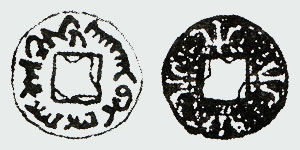
Sr19 Arslanids.
The end of the 9th – beginning of the 10th century. Obverse: Around the square hole is the Sogdian legend, read clockwise “of Mr. Arslan Bilge Kagan fan.” Reverse: Smooth, with four pressed signs in the form of a trident. (#54 A.M.Kamyshev, Early medieval coinage…, #46). Bronze.
/Rare/
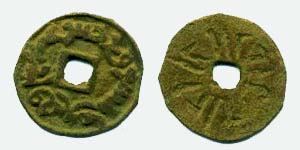
Sr20 Arslanids.
The end of the 9th – beginning of the 10th century. Obverse: Around the square hole is the Sogdian legend “Mr. Arslan Bilge Kagan fan.” Reverse: Smooth, with four pressed signs in the form of a trident. ( # 54 A.M. Kamyshev, Early medieval coinage…, # 47 ). Bronze.
D-21.5 mm.
Weight – 1.9 grams.
/Rare/ There are known coins with the Sogdian legend written in smaller handwriting on the obverse and stylized tamga-like characters in the form of dashes on the reverse.
(A.M. Kamyshev. #48)
Proto-Karakhanids
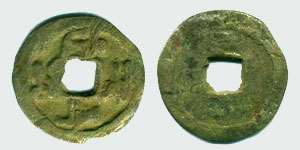
Sr21 Proto-Karakhanids.
Mid-10th century. Obverse: On the sides of the square hole there is a Kufic inscription, at the top is “malik”, to the right is “aram”, below is “yinal”, to the left is “chig”. Reverse: Smooth, no differences. ( # 54 A.M. Kamyshev, Early medieval coinage…, # 49 ). Bronze.
D-23.5 mm.
Weight: 4.8 grams.
/Very Rare/
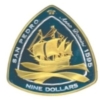




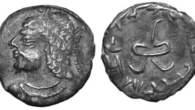
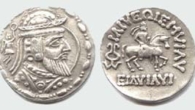
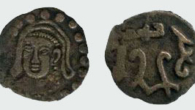
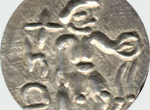
Leave a Reply